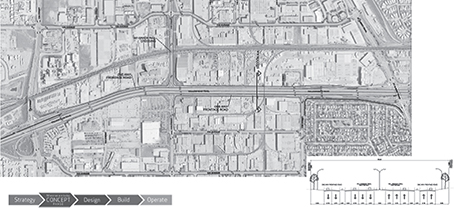The Interchange at 149th and Yellowhead Trail
Heather Stewart and Paul R. Messinger
In 2012, the Transportation Services Department conducted public-involvement planning and implementation for an interchange at 149th Street and Yellowhead Trail (see Figure 5.1). This project included early and open-ended public-involvement activities in an attempt to help avoid confusion and conflict around decision-making factors which had been a challenge in some previous major projects.

Figure 5.1 Preferred strategy: One-way service roads
The 149th Street Interchange at Yellowhead Trail project was part of an early phase of a long-term Yellowhead Trail Strategic Plan to develop the Yellowhead Trail into a freeway, which requires converting intersections into interchanges.
Planning
A typical public-involvement plan (PIP) starts with technical analysis and the drafting of a proposed concept plan for the project, which is presented at a public open house for feedback, adjusted in response to feedback, and presented at one or more cycles of further open houses to reach the Recommended Plan. This type of standard PIP focuses on the foundation level of the city of Edmonton’s Public Involvement continuum, “sharing information to build awareness.” The 149th Street project included Information Sharing as well as the next level in the continuum, Consultation (“Testing ideas or concepts to build knowledge” and “Collaborating to build commitment”). The most engaged level of public involvement, Active Participation (“Sharing decision-making” and “Delegating decision-making”) was not attempted for this project.(See p. 38 for the Public Involvement Continuum.)
Instead of starting with a proposed concept plan for an interchange and then running public-involvement activities to adjust that plan, the 149th Street project planned to collect public-involvement feedback first. Public-involvement activities were conducted alongside technical analysis as part of research study process in 2012 which informed the concept plan development in 2013.
Engagement
Public-involvement activities included open houses, and targeted interviews, and stakeholder input groups (SIGs). Open houses are typically advertised by a variety of means including roadside signs, but traditional printed roadside signs are banned on high speed roadways like Yellowhead Trail, so the project team successfully pioneered the use of existing electronic billboards to promote the open houses. Open houses and targeted interviews with business and community stakeholders provided information and collected feedback but also served as points of recruitment for a SIG of around 14 members. The SIG was assembled in summer 2012 and participated in a series of five workshops where key planning factors and options were explained, discussed, and evaluated. SIG feedback became a central element of the second Open House in which possible concept plan options were presented. The feedback was compiled and one final Recommended Option was presented to the community in early 2013.
Impact
The Recommended Option that resulted from this process suggests that public-involvement feedback did have an effect on project planning in this model. The assumption from the City of Edmonton throughout the project was that the solution would be a type of interchange, as reflected in the project title: “149th Street Interchange at Yellowhead Trail.” However after work-shopping various options with the SIG, the final conclusion was that the best solution (to balance community and business impacts with the need to make the Yellowhead Trail a free flow transportation corridor) was not in interchange. Instead a “right-in, right-out” style of intersection was selected as the final recommendation. This option allows access on and off of the Yellowhead from the right lanes but prevents crossing from one side of the Yellowhead to the other via 149th Street. This “right-in, right-out” model would cost approximately $200 million, versus approximately $400 million for a full freeway interchange.
Assessment and Learning
The project is currently in the final stages of technical concept planning and costing in the Facility and Capital Planning section. Interview feedback suggests that the process was labor-intensive but proceeded well.
Two distinctive features characterized the public-involvement process. (1) Public-involvement feedback to particular alternatives was collected as an input to and alongside concept planning. (2) SIGs were used, together with open houses, targeted interviews, and Internet questionnaires. While public involvement using all these features would only be considered in the future for the most sensitive and complex projects, the Facility and Capital Planning section is continuing to test the concept of gathering primary feedback prior to developing an initial concept plan for presentation at a public Open House. Internet questionnaires were also quite helpful, and similar rapid online feedback tools will likely be used to inform early concept plan design in the future.
Sources
Compiled from CPI interview research responses and the Transportation Service Department’s Public Involvement Plan (PIP).
